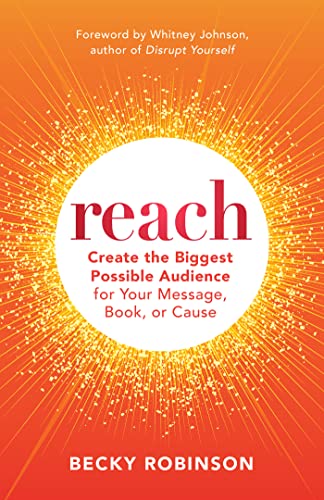
Lately when people have asked for recommendations about how to promote their books (either existing ones or those in process), I have steered them to Becky Robinson’s new book Reach: Create the Biggest Possible Audience for Your Message, Book, or Cause.
Becky is founder and CEO of the marketing agency Weaving Influence, and many of her clients have been published by Berrett-Koehler, the publisher of Reach and of my first book. Becky was also one of the facilitators for the recent BK virtual nonfiction book marketing workshop. I’ve made the recommendations not necessarily to guide them to working with Weaving Influence, but because the book provides a holistic approach to promotion, as just one (albeit very important) aspect of the creation and after-publication life of a book. Reach also lends itself to a DIY approach to promotion, should you choose that route.
As the title suggests, Reach is not necessarily just about promoting books. A message or cause you believe in may or may not involve writing a book, although as she points out, in many cases having a book is almost a necessity to amplify a message or cause. The book is written in such a way that it can be valuable for someone just starting out to those further along on their journeys. If you are in it for the long term, this book can be an excellent guide and companion.
One of the most compelling reasons to read Reach is its practical, no-nonsense, yet encouraging tone. It encourages you to not think too narrowly about whatever your are creating or promoting. At the same time, her message is realistic. She has met many people, especially potential clients, whose outsized expectations set themselves up for disappointment.
In comparing themselves to a rarified category of authors, deemed the “famous few,” such as Brené Brown, Ken Blanchard, Daniel Pink, and Simon Sinek, some people only focus on the outsized success and name recognition, not all the years of hard work and slogging that it took to get to their current status. Not to mention the time, effort, and resources to stay at a high level of awareness and recognition.
It’s fine to have goals and aspirations to potentially reach their level, but for most people it won’t happen. And as author Whitney Johnson points out in the foreword, “Fame does not guarantee that an individual’s work will be of value to others.” Yet there are many other metrics of success that are worth working toward. And the various frameworks in Reach seem doable and reasonable for accomplishing success on different levels. In this context, Becky explains that Reach= Expanding Audience + Lasting Impact. An organizing theme of her book is a set of the four commitments of Reach: Value, Consistency, Longevity, and Generosity.
The Reach Framework graphic helps readers consider the assorted aspects of reaching and influencing people, primarily online. “The starting point,” she writes, “for growing the influence of your message, book, or cause is your website. The center of the Framework has three components: your website, your social media presence, and your permission-based email list. Your website contains all your best content. Your social media presence makes new audiences aware of your work and you consistently post value there and seek to build genuine relationships with others.”
Another valuable graphic that displays at a glance the different assets you can leverage is “Repurposing a Core Content Asset,” on page 110. “Your Core Message” is in the middle, and various outlets radiate from it, including podcasts, webinars, speeches, videos, and newsletters. Here and elsewhere Becky includes examples and how-to content from her own work. There are also examples and mini-case-studies from such authors as David Cooperrider (Appreciative Inquiry), Jon Gordon (The Energy Bus), Bev Kaye (Love ‘Em or Lose ‘Em), and Natalie Nixon (The Creativity Leap). Cooperrider, Kaye, and Nixon are all Berrett-Koehler authors.
She also identifies what she terms “levels of influence,” which in no particular order and in her words are: Beginners, Masters of Branding, Traditional Thought Leaders, and True Reach Experts. Depending on which of these fluid categories you might currently be in, thinking about how they apply to your life and work will help ground you in an honest self-assessment, and guide your learning with benefits beyond the subject matter of your book, message, or cause.
Many people, authors or otherwise, have a hard time coming to terms with the idea of personal branding, and even recoil at the notion. Chapter 3, “Creating Your Brand,” may help demystify this concept and convince you why it is worthy of consideration, with this bracing reminder: “Your personal brand already exists. Your personal brand is your authentic self, who you are, all the quirks and characteristics that define you.” Her four steps of a branding strategy are 1. Define 2. Clarify 3. Identify and 4. Commit. “Make sure,” she writes, “the things you commit to are things you can do over a long period without burning out.”
Throughout Reach, Becky weaves in her own professional story, as well as a narrative about how Weaving Influence was formed a decade ago and continues to grow. With her strong and generous online presence and willingness to continually learn from her clients and other thought leaders, she and her book are worthy guides for a process that needs all the systematization and demystification it can get.
